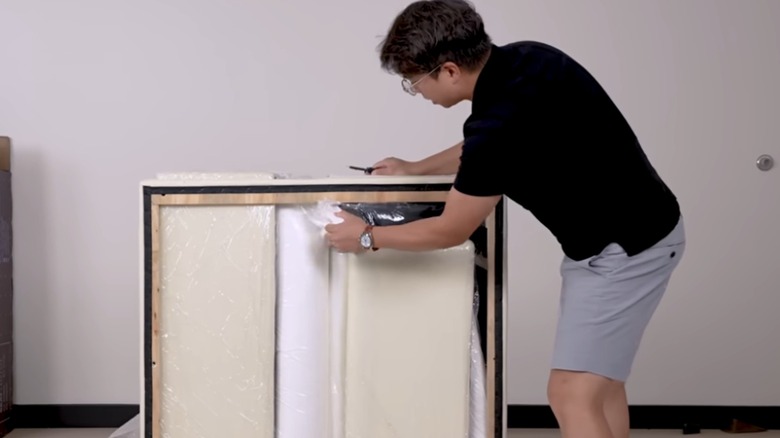Hidden Disadvantages To Buying A Couch In A Box That You Should Know About
One of the latest sofa trends gaining traction among homeowners and renters is the couch-in-a-box. While that may sound strange, we don't mean that the couch is just sitting in a box in your living room. The couch-in-a-box trend refers to purchasing a sofa online that's shipped directly to your house, often vacuum-sealed and perfectly situated in a convenient-to-ship package. One of the reasons people are vying for this couch alternative is that it removes some of the hassle of transporting a couch from a big-box store. Shipping costs could be lower than delivery and setup services, and these couches are generally more compact and modular. They're great for apartment dwellers and those needing versatility in small or odd-shaped spaces. However, the couch-in-a-box trend is not without its flaws, with some folks saying this could soon become one of those mistakes everyone makes when buying couches.
Issues with shipping, returns, and quality might pop up when buying any couch, but those delivered in boxes present unique challenges. These sofas are usually smaller and may not be as comfortable as the fully constructed units you'll find in a showroom. Further, one variety of "couch-in-a-box," the boneless couch, is made of only high-density foam layers that can lack structure and support. Boneless sofas are specifically designed to be frameless, but this often means they're not as durable or long-lasting as traditional couches, especially with heavy use. While some couch-in-a-box alternatives do arrive with structured components or built-in frames, parts aren't always shipped together and can be confusingly labeled. Regarding price, some couches-in-a-box could be more affordable (some cost less than $200) or on par with a traditional sofa, but shipping could increase the estimate.
Drawbacks of buying a sofa-in-a-box
While a sofa-in-a-box is an ultra-cozy alternative to bulky couches, there are several downsides worth considering. For starters, the cushions may be too firm or provide inconsistent support. Meanwhile, trends like the boneless cloud couch combat the firm modular options, but these slouchy frameless pieces may not hold their shape nearly as well. Another drawback is that these couches are typically smaller than a traditional sofa unit. While modular couch-in-a-box alternatives can be similar to a sectional, they are generally more low-profile and slimmer. This is great for apartments or tiny living rooms but may be less ideal in a larger space where the sofa feels disproportionate, and the often low-sitting backs don't provide long-term comfort.
Challenges with delivery, like long wait times and delays, may also occur with online ordering. Some homeowners have reported struggles with assembly as well. While some components will be well-labeled, opening the vacuum-sealed packages and figuring out the proper orientation for setup can be tricky. Another issue is that these couches don't always come in one box, and the various pieces may not arrive at the same time. However, the greatest issue many folks have faced with the couch-in-a-box trend is the return policies. Many companies request that the item be returned in its original packaging, which makes it even riskier to order a sofa sight unseen. Since the boneless couch-in-a-box is vacuum-sealed and expands upon opening, it can be impossible to vacuum-seal it back into the original box without proper equipment, meaning many homeowners cannot return their purchase.
Should you get a couch-in-a-box or buy the traditional way?
Whether you buy your sofa the traditional way or opt for a couch-in-a-box is up to you and your personal needs. Keep in mind that many couch-in-a-box setups are sold online only, meaning you can't try out the sofa before buying. Some homeowners have found issues with quality regarding online couch purchases, which have led many to revert back to buying sofas in-store, where they can touch and feel the product before buying.
However, there are also major downsides to buying big-box brand couches in-store. For example, many sectionals are sold with predetermined layouts and aren't as customizable as modular sofas-in-a-box. Further, modular couch-in-a-box setups are more ideal for tiny living spaces than a traditional sofa. And if you live in an apartment on the third floor, the couch-in-a-box could be easier to take upstairs than a traditional unit.
The quality, longevity, and durability of any couch-in-a-box or regular sofa will depend on the brand you choose. Maintenance will also vary based on the sofa material, but many couch-in-a-box alternatives have removable, washable covers and low-maintenance materials, making cleaning simple. Some experts suggest that if you're on the fence between a couch-in-a-box and a traditional sofa, consider whether your current living situation is permanent. Couches-in-a-box could be worth it for temporary stays, while traditional sofas are better for long-term living.


